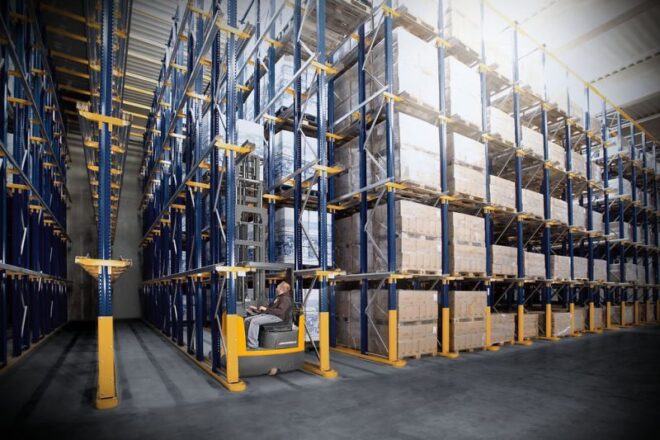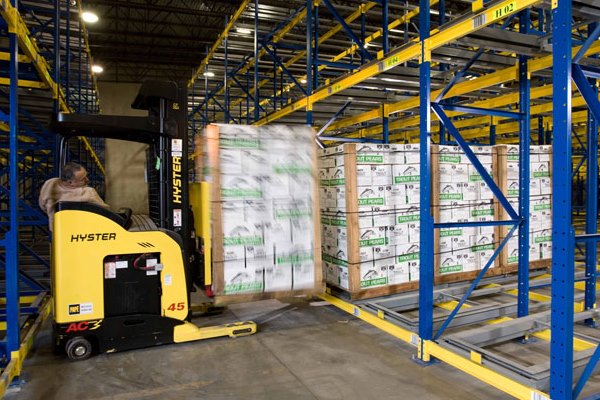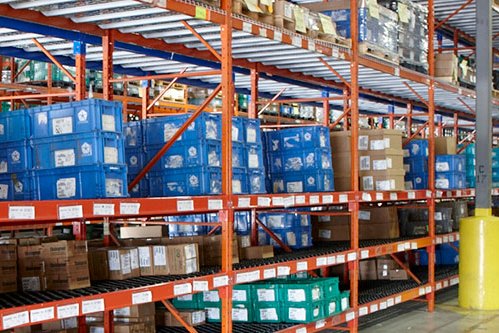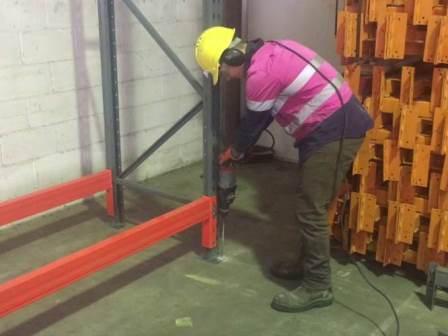Pallet Racking Types: Pallet racking is a material handling storage rack system designed to store products and materials on pallets in horizontal rows and on multiple levels. Most warehouses prefer using pallet racking systems to maximize the storage space they have available.
Since they come in a variety of systems depending on your specific needs, it can often be difficult to decide what type to choose of pallet rack for your warehouse. Pallet racking is made up of horizontal cross beams that attach to vertical upright frames – thus creating industrial shelving to support palletized material that can be easily accessed by forklifts.

Types of pallet racking
Types of racking system:
However, while these systems have significant storage advantages, a lot needs to be considered when adding pallet racking to your warehouse.
To make this process easier for you, here’s a breakdown of the most common types of pallet racking systems:
Selective pallet racking
The most versatile choice, selective pallet racking is popular as it provides immediate access to every pallet position – meaning you can have as many SKUs as you have pallet positions. Making it the most flexible solution for changing warehouses.
- Easiest to reconfigure / add-on
- Lowest initial investment
- Highest operating costs
- Least dense
- Ideal for low volume; high SKU count
- FIFO inventory rotation
Given the standard nature of the product and limited engineering requirements, it has the lowest initial investment. But, it requires numerous aisles and has the lowest storage density.
The industry-standard for the selective rack is teardrop style pallet racking. The boltless hardware-free design featured on modern brands makes selective racking easy to assemble, reconfigure and re slot.
Double-deep racking, a variant of the standard selective rack allows pallets to be stored two-deep, but still maintains accessibility. To access the rear pallet load, the front pallet position must be empty, and you must have a forklift that can reach two pallets deep. Upper levels can be fitted with guide rails to assist forklift drivers in locating pallets.
To ensure FIFO accounting, two pallets with the same product are stored in a slot of the double-deep rack.

Drive in drive through racking system
By eliminating aisles drive-in rack prioritizes density over selectivity to deliver maximum storage density. In fact, a drive-in rack system can increase pallet storage by as much as 60% – 75% when compared to a selective rack. But, offers less selectivity than selective racking.
Each bay is typically dedicated to a single product. They work well where an entire bay of product is moved at once, such as in staging products for shipping. Mostly used when you have seasonal items that move quickly in and out of inventory.
When you have limited space or high operational costs like cold rooms and freezers. Drive-in systems are designed for the specific product they are storing. The highly engineered nature of the system makes it difficult to reconfigure or re-slot a drive-in or drive-through system.
- Ideal for high volume; Low SKU count
- Greatest storage density
- Low initial investment
- FIFO inventory rotation (drive-through)
- LIFO inventory rotation (drive-in)
A variant of a drive-in, the drive-through rack has an entrance at both ends of the system. While the additional entrance reduces storage density, it allows for FIFO inventory rotation.
When used incorrectly, “honeycombing” can potentially occur. Honeycombing occurs when excess racking goes unoccupied due to poor inventory cycling.
Lower initial investment than a pallet flows racking system.
Designing the system out of structural racking limits damage from fork truck operators driving in and out of the system and lowers ongoing operating costs.

Push back racking system
Push-Back Racking: It requires less space than flow racking because you don’t need an aisle at the back to load the product. Unlike a single-deep pallet rack, a dynamic pushback system allows the storage of pallets two to five deep. Unlike drive-in rack, push-back provides easy access to a variety of different SKUs. Pallets are stored behind each other in a series of nested carts and are loaded from the same side of the system, eliminating separate aisles for each function. When one pallet is pulled, the one behind it rolls forward.
It can decrease labor costs and is relatively low maintenance.
Similar to flow rack, except the pallets, are loaded and unloaded from the front of the system. The pallets can rest on either nested carts or gravity rollers. You only need one aisle for unloading and loading. But, can only be stored 4 to 5 pallets deep. Operates under a LIFO inventory system since the most recent pallet is the first one available.
- Similar SKU access to selective, but more density
- Hard to reconfigure due to engineering requirements
- Ideal for medium quantities of homogenous products
- High initial investment
- LIFO inventory rotation
Great alternative if you don’t have enough product to satisfy the ‘Rule of Three’. With ever-increasing pressure to decrease inventories, few have enough pallets of a single, particular SKU to fully utilize a drive-in system. Hence, pushback, which allows users to efficiently store smaller lots, is growing in popularity.

Pallet flow racking system
Pallet Flow Racking: Combines a stationary rack structure with a skate wheel or roller conveyor to create a dynamic storage system.
Pallets are loaded into the back end of the rack then travel down the slightly inclined plane of the conveyor so they can be retrieved from the front. Because there is more engineering involved, they are more expensive than others.
Gravity flow pallet rack systems use metal rollers and the force of gravity to feed pallets to the front of the system, where they’re unloaded. Like drive-in, they maximize storage space by minimizing aisles. Unlike drive-in systems, they operate on a first-in, first-out (FIFO) inventory rotation.
They are custom engineered to meet a need and can store as many as 20 pallets per storage lane. They are usually made using structural racking. Pallet flow has the highest investment when compared to other storage options, but there is no need for drivers to enter the system, so operating costs are lower than drive-in rack since it isn’t damaged as often.
- High density, low SKU access
- Ideal for coolers, freezers or other expensive operating environments
- Automatic FIFO product rotation
- Hard to reconfigure due to engineering requirements
- Highest initial investment
In order to ensure you have enough product to make a pallet flow system work, you’ll want to consider the “Rule of Three”. This general rule is a quick way to determine if you have enough pallets to make the system work. For example, if you are considering a 15 deep pallet flow rack system, you’ll want to have a minimum of 45 pallets of that specific product. Any less and you’ll find yourself with a system that isn’t being utilized and/or honeycombing.
Once loaded, FIFO product rotation is automatic and the rack eliminates the need for additional labor or forklift operation to arrange loads. Forklifts are only required for the initial and final unloading. Since only two aisles are necessary, aisle space can be reduced by 75% and up to 100% more products can be stored than a traditional selective pallet racking system.
Pallet flows entry guides can be installed to improve pallet flow in the lanes and allow more forgiving pallet placement.

Carton flow racking
Accommodates high-volume order picking and reduces the need for operator activity. Similar to pallet flow racking, carton flow racking uses gravity to ‘flow’ cartons and boxes down rollers.
Carton flow has numerous advantages: It operates with FIFO order picking, it can lower labor costs and it is compatible with existing teardrop style pallet racking.
- Ideal for picking by the piece or case
- Easy to reconfigure
- Highest SKU access
- Automatic FIFO inventory rotation

Cantilever racking system
Designed for products that are long, irregular, and awkwardly shaped. They are ideal for storing non-standard sized items, such as tubing doors and packs of timber or furniture. Relatively easy to install and reconfigure. It is not ideal for storing pallets.
- Ideal for long, bulky items
- Easy to reconfigure
- Single-sided can be converted to double-sided
Ideal for storing long items in continuous horizontal runs because there are no upright frames in the way. Lacks front side obstructions, making loading and picking easier. It can be built as high as service machinery will go. Single-sided can convert to double-sided.

Racking system design
A properly designed racking system can increase productivity and add significantly to your bottom line. This is especially important at a time when labor is scarce and the price of warehouse space continues to increase.
Pallet racking systems can typically be divided into two broad categories: low-density systems that allow easy access to product or high-density systems that make better use of space but limit access to stored product. Given the unique nature of each system, typically see two or more systems in a warehouse.
Any storage solution should target 75 percent occupancy as the minimum acceptable utilization. But, when utilization surpasses 85%, there is typically a corresponding reduction in warehouse productivity. In many cases, the lifespan of a warehouse can be extended by simply changing the type of storage systems in use.
But, before analyzing any particular system you’ll want to collect some basic information:
- Capacity needs: Number of SKUs / products and the number of pallets per product
- Dimensions of a typical pallet load
- Do You Need FIFO or LIFO Accounting?
- Typical incoming and outgoing quantities and picking profiles
- How often do you need to access the product?
Combining different types of teardrop style pallet racking with a warehouse execution or management system offers optimum efficiency and use of available floor space. As a result, you will reduce the costs of managing inventory, including damage, obsolesce, and carrying costs.
What are the different types of pallet racking?
To make this process easier for you, here’s a breakdown of the most common types of pallet racking systems:
-Cantilever Racking.
-Selective Racking.
-Push Back Racking.
-Drive-In Racking.
-Pallet Flow Racking.
-Carton Flow Racking.
Selective pallet racking is the most commonly used pallet racking system. These systems are called “selective” because they allow users to select any pallet load from the pallet racking system without having to move any other pallets.
The most read

Pallet Racking system
Selecting warehouse storage rack systems involves careful planning and appropriate system choices to ensure you get the most from your capital expenditures, reduce overhead, and respond quickly to distribution needs.

How to secure pallet racking to the floor?
Pallet storage and pallet rack installation jobs require an experienced crew with the proper tools and equipment. Many people involved in pallet racking jobs don’t really know how to install a pallet rack.
